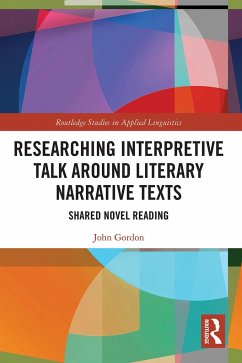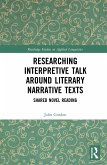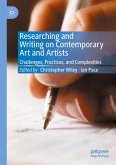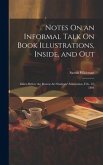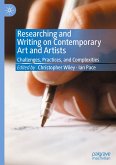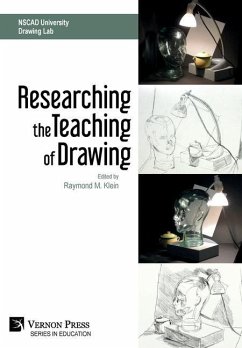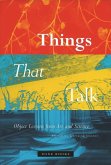- Broschiertes Buch
- Merkliste
- Auf die Merkliste
- Bewerten Bewerten
- Teilen
- Produkt teilen
- Produkterinnerung
- Produkterinnerung
Drawing on a multidisciplinary approach integrating insights from conversation analysis, narrative analysis, and narratology, this book theorizes teaching around narrative prose in each level of education, with a focus on a new framework of Pedagogic Literary Narration which emphasizes the practice of shared novel reading and the importance of the role of the teacher in mediating this practice. // With insights taken from a comprehensive set of transcripts taken from actual classrooms, the volume focuses on the convention in native-tongue literary study in which teachers and students read a…mehr
Andere Kunden interessierten sich auch für
![Researching Interpretive Talk Around Literary Narrative Texts Researching Interpretive Talk Around Literary Narrative Texts]() John GordonResearching Interpretive Talk Around Literary Narrative Texts195,99 €
John GordonResearching Interpretive Talk Around Literary Narrative Texts195,99 €![Researching and Writing on Contemporary Art and Artists Researching and Writing on Contemporary Art and Artists]() Researching and Writing on Contemporary Art and Artists100,99 €
Researching and Writing on Contemporary Art and Artists100,99 €![Notes On an Informal Talk On Book Illustrations, Inside, and Out: Given Before the Boston Art Students' Association, Feb. 14, 1894 Notes On an Informal Talk On Book Illustrations, Inside, and Out: Given Before the Boston Art Students' Association, Feb. 14, 1894]() Sarah WhitmanNotes On an Informal Talk On Book Illustrations, Inside, and Out: Given Before the Boston Art Students' Association, Feb. 14, 189429,99 €
Sarah WhitmanNotes On an Informal Talk On Book Illustrations, Inside, and Out: Given Before the Boston Art Students' Association, Feb. 14, 189429,99 €![Researching and Writing on Contemporary Art and Artists Researching and Writing on Contemporary Art and Artists]() Researching and Writing on Contemporary Art and Artists100,99 €
Researching and Writing on Contemporary Art and Artists100,99 €![Researching the Teaching of Drawing (B&W) Researching the Teaching of Drawing (B&W)]() Researching the Teaching of Drawing (B&W)97,99 €
Researching the Teaching of Drawing (B&W)97,99 €![Researching the Teaching of Drawing (Color) Researching the Teaching of Drawing (Color)]() Researching the Teaching of Drawing (Color)110,99 €
Researching the Teaching of Drawing (Color)110,99 €![Things That Talk Things That Talk]() Lorraine Daston (ed.)Things That Talk31,99 €
Lorraine Daston (ed.)Things That Talk31,99 €-
-
-
Drawing on a multidisciplinary approach integrating insights from conversation analysis, narrative analysis, and narratology, this book theorizes teaching around narrative prose in each level of education, with a focus on a new framework of Pedagogic Literary Narration which emphasizes the practice of shared novel reading and the importance of the role of the teacher in mediating this practice. // With insights taken from a comprehensive set of transcripts taken from actual classrooms, the volume focuses on the convention in native-tongue literary study in which teachers and students read a novel shared over lessons, combining periods of reading aloud with those of questioning and discussion. In so doing, Gordon seeks to extend existing methodologies from literary and social science research toward informing teaching practice in literary pedagogy and address the need for a theorization of literary pedagogy which considers the interrelationship between text-in-print and text-through-talk. Transcripts are supported with comprehensive analyses to help further explicate the research methodology and provide guidance on implementing it in the classroom. // This book is a valuable resource for scholars in language and education, literary studies, narrative inquiry, and education research.
Hinweis: Dieser Artikel kann nur an eine deutsche Lieferadresse ausgeliefert werden.
Hinweis: Dieser Artikel kann nur an eine deutsche Lieferadresse ausgeliefert werden.
Produktdetails
- Produktdetails
- Verlag: Routledge
- Seitenzahl: 260
- Erscheinungstermin: 6. Mai 2022
- Englisch
- Abmessung: 229mm x 152mm x 14mm
- Gewicht: 382g
- ISBN-13: 9780367564599
- ISBN-10: 0367564599
- Artikelnr.: 69890004
- Herstellerkennzeichnung
- Libri GmbH
- Europaallee 1
- 36244 Bad Hersfeld
- gpsr@libri.de
- Verlag: Routledge
- Seitenzahl: 260
- Erscheinungstermin: 6. Mai 2022
- Englisch
- Abmessung: 229mm x 152mm x 14mm
- Gewicht: 382g
- ISBN-13: 9780367564599
- ISBN-10: 0367564599
- Artikelnr.: 69890004
- Herstellerkennzeichnung
- Libri GmbH
- Europaallee 1
- 36244 Bad Hersfeld
- gpsr@libri.de
John Gordon is Senior Lecturer in Education at the School of Education and Lifelong Learning at the University of East Anglia, UK.
Contents
Chapter 1:
Literary study and shared novel reading in education
1.0 Introduction
1.1 Shared literary reading
1.2 Literary study in education: an overview
1.2.1 Literary pedagogy for supporting students' comprehension of texts
1.2.2 Conceptualisations of reading
1.2.3 The role of classroom talk in reading
1.3 Shared novel reading
1.4 Readers' experiences of shared novel reading in education
1.4.1 Questionnaire design and questions
1.4.2 Survey results
1.4 Summary
Chapter 2:
Researching conversations about literature in schools and universities
2.0 Introduction
2.1 Research in the discipline of literary study: some examples
2.1.1 Practical Criticism as research-informed practice
2.1.2 Louise Rosenblatt: 'Reader Text Poem'
2.1.3 Systematic Functional Linguistics and the verbal arts
2.2 Researching learning conversations
2.3 Researching how voices mediate texts for literary study
2.4 Summary
Chapter 3:
Novels, narratives and narratology
3.0 Introduction
3.1 Key terms
3.1.1 Narrative
3.1.2 Narration
3.1.3 Narratology / narratologies
3.2 The novel as a narrative form: the literary studies perspective
3.3 Novels in education
3.4 Classical narratologies and their use in school English
3.4.1 Propp's morphology of narrative
3.4.2 Narrative analysis: Labov and Waletzy
3.4.3 Genette and narrative voice
3.4.4 Narrative time: Ricoeur
3.5 New narratologies and their use in researching literary study
3.6 Summary
Chapter 4
Theorising Pedagogic Literary Narration: towards a new narratology of
literary study conversations
4.0 Introduction
4.1 Pedagogic Literary Narration
4.1.1 Pedagogic Literary Narration as narration-in-interaction
4.2 Adapting the resources of conversation analysis to literary study
contexts
4.3 A three-way view of context for literary study
4.3.1 View 1: institutional contexts for literary study interaction
4.3.2 View 2: Pedagogic Literary Narration as classroom context
4.2.3 View 3: the micro context of Pedagogic Literary Narration in action
4.4 Data sources, settings and participants for this research
4.4.1 Observing shared novel reading in action
4.5 Adapting conversation analysis to Pedagogic Literary Narration
4.6 Reducing and coding conversational literary study data
4.6.1 Stage one: the classroom context of Pedagogic Literary Narration
4.6.2 Stage two: the microcontext of Pedagogic Literary Narration
4.7 An approach to analysing examples of Pedagogic Literary Narration
4.8 Summary
4.8.1 Pedagogic Literary Narration as a classroom context realised in
teacher exposition
4.8.2 Towards Pedagogic Literary Narration as micro context: teacher-quoted
narration
Chapter 5:
Pedagogic Literary Narration in action
5.0 Introduction
5.1 The focal text: an extract from The Strange Case of Dr Jekyll and Mr
Hyde
5.2 An extract from The Strange Case of Dr Jekyll and Mr Hyde discussed in
the transcript
5.3 Pedagogic Literary Narration as micro context
5.3.1 Narrating, demonstrating and analysing suspense in teacher exposition
5.3.2 Orchestrating narration, review and analysis through talk
5.4 Theorising narratives and narrative analysis for literary pedagogy
5.4.1 Reviewing Pedagogic Literary Narration in the three-way view of
literary study
5.4.2 The nature of narration in Pedagogic Literary Narration
5.4.3 Heteroglot teacher exposition
5.4.4 Recognising some limitations of Pedagogic Literary Narration and
these research methods
5.5 Summary
Chapter 6:
Spoken quotation in Pedagogic Literary Narration: Introducing QuoTE
Analysis
6.0 Introduction
6.0.1 Focal texts: Jekyll and Hyde, and The Boy in the Striped Pyjamas
6.0.2 Examples of spoken quotation in shared novel reading
6.1 Reader positioning around quotations in literary study
6.1.1 Quotation in literary study
6.1.2 Positioning theory for literary pedagogy
6.2 Quotations: From page to talk
6.3 The turn of the page: Study text as participant in literary-critical
talk
6.4 The third turn or mini-lecture in classroom interaction
6.5 QuoTE analysis
6.6 Spoken quotation in shared literary reading
6.6.1 Spoken quotation in teacher exposition, senior classroom
6.6.2 Spoken quotation in on-going read-aloud talk, junior classroom
6.7 Spoken quotations in literary-critical talk
6.8 Summary
Chapter 7:
Elaborating characters through conversation
7.0 Introduction
7.1 Elaborating character development together in primary school
7.1.1 Establishing character development as a focus
7.1.2 Accounting for character development together
7.1.3 Indexing a psychological character trait
7.1.4 Elaborating character development together in Pedagogic Literary
Narration
7.2 Conceptualising character together in secondary school
7.3 Analysing character through intertexts in higher education
7.3.1 The focal text: Tom Jones by Henry Fielding
7.3.2 Discussing characterisation in Tom Jones
7.4 Summary
Chapter 8:
Discussing literary narratives in higher education: intertextuality and
tethering
8.0 Introduction
8.1 A university seminar in a Contemporary Fiction module of literary study
8.2 The focal text: Pond, by Claire-Louise Bennett
8.3 Critical intertexts influencing seminar discussion
8.3.1 An online review of Pond
8.3.2 A published interview with Pond's author, Claire-Louise Bennet
8.4 Intertextuality, positioning theory and interaction
8.4.1 What is intertextuality?
8.4.2 Positioning theory and intertextuality
8.5 Intertexuality in seminar discussion
8.5.1 Invoking texts and invocations
8.5.2 Call codes: identifying the many voices of intertexts
8.5.3 Lemke's categories of intertextual relationship
8.6 Discussing 'Pond' together: Conversation analysis
8.6.1 Discussing 'Pond' together: transcript
8.6.2 How do participants enact intertextual literary analysis in
conversation?
8.6.3 How are intertextual voices introduced?
8.6.4 How do intertextual voices relate to focal texts and position
readers' orientations to them?
8.7 Tethering intertextual talk
8.8 Summary
Chapter 9:
Building themes together: Talk about literary novels in and beyond formal
education
9.0 Introduction
9.0.1 Shared reading in an informal book group
9.0.2 Focal text: Life after Life by Kate Atkinson
9.03 Finding an analytic approach suited to informal shared literary
reading
9.1 Framing shared literary reading of Life after Life
9.1.0 Participants frame conversation about Life after Life: an informal
agenda
9.1.1 Framing book group conversation for analysis
9.2 Life after Life: extended plain text transcripts
9.2.1 Plain transcript 1: representing parallel life stories, and catalyst
events
9.2.2 Plain transcript 2: chance and the 'what if' conceit
9.2.3 Plain transcript 3: form and Life after Life as a 'what if' book
9.2.4 Plain transcript 4: Constant Izzie and déjà vu - 'time is not linear'
9.3 Discussing Life after Life: Conversation analysis
9.3.0 Repetition as a resource in conversation
9.4.0 Annotated transcript 1: maintaining diffuse text topics through
repetition - 'in Germany'
9.3.2 Annotated transcript 2: collective text analysis through
categorisation statements - 'the what if scenario'
9.3.3 Annotated transcript 3: considering the novel's form by proxy -
'difficult to film'
9.3.4 Annotated transcript 4: deictic analysis - 'time is not linear'
9.4 Summary
Chapter 10
Discussing and navigating narrative form: How texts shape talk
10.0 Introduction
10.1 The epistolary form of Daddy Long-legs and genre theory
10.1.1 The epistolary novel
10.1.2 Genre theory
10.2 Positioning theory and short stories
10.3 Short storying to position reading and readers of Daddy Long-legs
10.3.1 Short storying to express and invite reading positions to Daddy
Long-legs
10.3.2 Reporting the focal text narrative: short story summaries
10.4 Orienting to analytic reading positions around Daddy Long-legs
10.4.1 Reader positioning arising from focal text form
10.4.2 Reader positioning oriented to focal text as a generic object
10.5 Summary
Chapter 11
Developing Pedagogic Literary Narration for teaching literature
11.0 Introduction
11.1 Literary classroom discourse as pedagogic device
11.1.1 The pedagogic device
11.1.2 Public language
11.1.3 Language codes
11.1.4 The value of 'restricted' shared reading conversations
11.2 Connecting reading group conversations with formal education
11.2.1 Extra-narration in reading groups relative to formal literary
education
11.2.2 Paraphrased narrative in reading group conversations
11.2.3 Intertextual text invocation in reading group conversations
11.2.4 'Talkable texts': repetition and synecdochic indexing in reading
group talk
11.3 Reviewing shared literary reading in formal education
11.3.1 Involvement, narration and positioning
11.3.2 Turn-taking patterns and the collective achievement of literary
analysis
11.3.3 Initiate-response-evaluate, teacher exposition and the pedagogic
device of
literary study
11.3.4 Spoken quotation: an essential feature of spoken literary discourse?
11.3.5 How and how much texts enter talk
11.4 Summary
Chapter 12:
Interpretive talk around literary narrative texts: an overview
12.0 An overview
12.1 The analytic resources generated by this study
12.2 A narratology for interpretive talk around literary narrative texts
12.2.1 The significance of this narratology for education research
12.2.2 The significance of shared novel reading and Pedagogic Literary
Narration for education
12.3 New stories for teachers of literature
12.3.1 Eavesdropping on shared novel reading in teacher education
12.3.2 Teacher-researchers: shared literary reading in a Masters-level
programme
12.4 Summary
Tables
Table 4.1 Shared novel reading: observed examples
Table 4.2 Focal class data, The Strange Case of Dr Jekyll and Mr Hyde
Table 4.3 Teacher exposition, teacher-quoted narrative comprising
multi-quotation turns
Table 6.1 Positioning affordances of spoken quotation in literary pedagogy
Table 8.1 Call codes - voices of human agents
Table 8.2 Call codes - verbal text voices
Table 10.1 Three levels of positioning questions, after Rattansi & Phoenix
Table 12.1 Key terms for researching interpretive talk around literary
narrative texts during shared novel reading
Figures
Figure 12.1 A post-classical narratology for interpretive talk around
literary narrative texts
Figure 12.2 Shared novel reading: observing other teachers / evaluating
your own teaching
References
Appendix
Chapter 1:
Literary study and shared novel reading in education
1.0 Introduction
1.1 Shared literary reading
1.2 Literary study in education: an overview
1.2.1 Literary pedagogy for supporting students' comprehension of texts
1.2.2 Conceptualisations of reading
1.2.3 The role of classroom talk in reading
1.3 Shared novel reading
1.4 Readers' experiences of shared novel reading in education
1.4.1 Questionnaire design and questions
1.4.2 Survey results
1.4 Summary
Chapter 2:
Researching conversations about literature in schools and universities
2.0 Introduction
2.1 Research in the discipline of literary study: some examples
2.1.1 Practical Criticism as research-informed practice
2.1.2 Louise Rosenblatt: 'Reader Text Poem'
2.1.3 Systematic Functional Linguistics and the verbal arts
2.2 Researching learning conversations
2.3 Researching how voices mediate texts for literary study
2.4 Summary
Chapter 3:
Novels, narratives and narratology
3.0 Introduction
3.1 Key terms
3.1.1 Narrative
3.1.2 Narration
3.1.3 Narratology / narratologies
3.2 The novel as a narrative form: the literary studies perspective
3.3 Novels in education
3.4 Classical narratologies and their use in school English
3.4.1 Propp's morphology of narrative
3.4.2 Narrative analysis: Labov and Waletzy
3.4.3 Genette and narrative voice
3.4.4 Narrative time: Ricoeur
3.5 New narratologies and their use in researching literary study
3.6 Summary
Chapter 4
Theorising Pedagogic Literary Narration: towards a new narratology of
literary study conversations
4.0 Introduction
4.1 Pedagogic Literary Narration
4.1.1 Pedagogic Literary Narration as narration-in-interaction
4.2 Adapting the resources of conversation analysis to literary study
contexts
4.3 A three-way view of context for literary study
4.3.1 View 1: institutional contexts for literary study interaction
4.3.2 View 2: Pedagogic Literary Narration as classroom context
4.2.3 View 3: the micro context of Pedagogic Literary Narration in action
4.4 Data sources, settings and participants for this research
4.4.1 Observing shared novel reading in action
4.5 Adapting conversation analysis to Pedagogic Literary Narration
4.6 Reducing and coding conversational literary study data
4.6.1 Stage one: the classroom context of Pedagogic Literary Narration
4.6.2 Stage two: the microcontext of Pedagogic Literary Narration
4.7 An approach to analysing examples of Pedagogic Literary Narration
4.8 Summary
4.8.1 Pedagogic Literary Narration as a classroom context realised in
teacher exposition
4.8.2 Towards Pedagogic Literary Narration as micro context: teacher-quoted
narration
Chapter 5:
Pedagogic Literary Narration in action
5.0 Introduction
5.1 The focal text: an extract from The Strange Case of Dr Jekyll and Mr
Hyde
5.2 An extract from The Strange Case of Dr Jekyll and Mr Hyde discussed in
the transcript
5.3 Pedagogic Literary Narration as micro context
5.3.1 Narrating, demonstrating and analysing suspense in teacher exposition
5.3.2 Orchestrating narration, review and analysis through talk
5.4 Theorising narratives and narrative analysis for literary pedagogy
5.4.1 Reviewing Pedagogic Literary Narration in the three-way view of
literary study
5.4.2 The nature of narration in Pedagogic Literary Narration
5.4.3 Heteroglot teacher exposition
5.4.4 Recognising some limitations of Pedagogic Literary Narration and
these research methods
5.5 Summary
Chapter 6:
Spoken quotation in Pedagogic Literary Narration: Introducing QuoTE
Analysis
6.0 Introduction
6.0.1 Focal texts: Jekyll and Hyde, and The Boy in the Striped Pyjamas
6.0.2 Examples of spoken quotation in shared novel reading
6.1 Reader positioning around quotations in literary study
6.1.1 Quotation in literary study
6.1.2 Positioning theory for literary pedagogy
6.2 Quotations: From page to talk
6.3 The turn of the page: Study text as participant in literary-critical
talk
6.4 The third turn or mini-lecture in classroom interaction
6.5 QuoTE analysis
6.6 Spoken quotation in shared literary reading
6.6.1 Spoken quotation in teacher exposition, senior classroom
6.6.2 Spoken quotation in on-going read-aloud talk, junior classroom
6.7 Spoken quotations in literary-critical talk
6.8 Summary
Chapter 7:
Elaborating characters through conversation
7.0 Introduction
7.1 Elaborating character development together in primary school
7.1.1 Establishing character development as a focus
7.1.2 Accounting for character development together
7.1.3 Indexing a psychological character trait
7.1.4 Elaborating character development together in Pedagogic Literary
Narration
7.2 Conceptualising character together in secondary school
7.3 Analysing character through intertexts in higher education
7.3.1 The focal text: Tom Jones by Henry Fielding
7.3.2 Discussing characterisation in Tom Jones
7.4 Summary
Chapter 8:
Discussing literary narratives in higher education: intertextuality and
tethering
8.0 Introduction
8.1 A university seminar in a Contemporary Fiction module of literary study
8.2 The focal text: Pond, by Claire-Louise Bennett
8.3 Critical intertexts influencing seminar discussion
8.3.1 An online review of Pond
8.3.2 A published interview with Pond's author, Claire-Louise Bennet
8.4 Intertextuality, positioning theory and interaction
8.4.1 What is intertextuality?
8.4.2 Positioning theory and intertextuality
8.5 Intertexuality in seminar discussion
8.5.1 Invoking texts and invocations
8.5.2 Call codes: identifying the many voices of intertexts
8.5.3 Lemke's categories of intertextual relationship
8.6 Discussing 'Pond' together: Conversation analysis
8.6.1 Discussing 'Pond' together: transcript
8.6.2 How do participants enact intertextual literary analysis in
conversation?
8.6.3 How are intertextual voices introduced?
8.6.4 How do intertextual voices relate to focal texts and position
readers' orientations to them?
8.7 Tethering intertextual talk
8.8 Summary
Chapter 9:
Building themes together: Talk about literary novels in and beyond formal
education
9.0 Introduction
9.0.1 Shared reading in an informal book group
9.0.2 Focal text: Life after Life by Kate Atkinson
9.03 Finding an analytic approach suited to informal shared literary
reading
9.1 Framing shared literary reading of Life after Life
9.1.0 Participants frame conversation about Life after Life: an informal
agenda
9.1.1 Framing book group conversation for analysis
9.2 Life after Life: extended plain text transcripts
9.2.1 Plain transcript 1: representing parallel life stories, and catalyst
events
9.2.2 Plain transcript 2: chance and the 'what if' conceit
9.2.3 Plain transcript 3: form and Life after Life as a 'what if' book
9.2.4 Plain transcript 4: Constant Izzie and déjà vu - 'time is not linear'
9.3 Discussing Life after Life: Conversation analysis
9.3.0 Repetition as a resource in conversation
9.4.0 Annotated transcript 1: maintaining diffuse text topics through
repetition - 'in Germany'
9.3.2 Annotated transcript 2: collective text analysis through
categorisation statements - 'the what if scenario'
9.3.3 Annotated transcript 3: considering the novel's form by proxy -
'difficult to film'
9.3.4 Annotated transcript 4: deictic analysis - 'time is not linear'
9.4 Summary
Chapter 10
Discussing and navigating narrative form: How texts shape talk
10.0 Introduction
10.1 The epistolary form of Daddy Long-legs and genre theory
10.1.1 The epistolary novel
10.1.2 Genre theory
10.2 Positioning theory and short stories
10.3 Short storying to position reading and readers of Daddy Long-legs
10.3.1 Short storying to express and invite reading positions to Daddy
Long-legs
10.3.2 Reporting the focal text narrative: short story summaries
10.4 Orienting to analytic reading positions around Daddy Long-legs
10.4.1 Reader positioning arising from focal text form
10.4.2 Reader positioning oriented to focal text as a generic object
10.5 Summary
Chapter 11
Developing Pedagogic Literary Narration for teaching literature
11.0 Introduction
11.1 Literary classroom discourse as pedagogic device
11.1.1 The pedagogic device
11.1.2 Public language
11.1.3 Language codes
11.1.4 The value of 'restricted' shared reading conversations
11.2 Connecting reading group conversations with formal education
11.2.1 Extra-narration in reading groups relative to formal literary
education
11.2.2 Paraphrased narrative in reading group conversations
11.2.3 Intertextual text invocation in reading group conversations
11.2.4 'Talkable texts': repetition and synecdochic indexing in reading
group talk
11.3 Reviewing shared literary reading in formal education
11.3.1 Involvement, narration and positioning
11.3.2 Turn-taking patterns and the collective achievement of literary
analysis
11.3.3 Initiate-response-evaluate, teacher exposition and the pedagogic
device of
literary study
11.3.4 Spoken quotation: an essential feature of spoken literary discourse?
11.3.5 How and how much texts enter talk
11.4 Summary
Chapter 12:
Interpretive talk around literary narrative texts: an overview
12.0 An overview
12.1 The analytic resources generated by this study
12.2 A narratology for interpretive talk around literary narrative texts
12.2.1 The significance of this narratology for education research
12.2.2 The significance of shared novel reading and Pedagogic Literary
Narration for education
12.3 New stories for teachers of literature
12.3.1 Eavesdropping on shared novel reading in teacher education
12.3.2 Teacher-researchers: shared literary reading in a Masters-level
programme
12.4 Summary
Tables
Table 4.1 Shared novel reading: observed examples
Table 4.2 Focal class data, The Strange Case of Dr Jekyll and Mr Hyde
Table 4.3 Teacher exposition, teacher-quoted narrative comprising
multi-quotation turns
Table 6.1 Positioning affordances of spoken quotation in literary pedagogy
Table 8.1 Call codes - voices of human agents
Table 8.2 Call codes - verbal text voices
Table 10.1 Three levels of positioning questions, after Rattansi & Phoenix
Table 12.1 Key terms for researching interpretive talk around literary
narrative texts during shared novel reading
Figures
Figure 12.1 A post-classical narratology for interpretive talk around
literary narrative texts
Figure 12.2 Shared novel reading: observing other teachers / evaluating
your own teaching
References
Appendix
Contents
Chapter 1:
Literary study and shared novel reading in education
1.0 Introduction
1.1 Shared literary reading
1.2 Literary study in education: an overview
1.2.1 Literary pedagogy for supporting students' comprehension of texts
1.2.2 Conceptualisations of reading
1.2.3 The role of classroom talk in reading
1.3 Shared novel reading
1.4 Readers' experiences of shared novel reading in education
1.4.1 Questionnaire design and questions
1.4.2 Survey results
1.4 Summary
Chapter 2:
Researching conversations about literature in schools and universities
2.0 Introduction
2.1 Research in the discipline of literary study: some examples
2.1.1 Practical Criticism as research-informed practice
2.1.2 Louise Rosenblatt: 'Reader Text Poem'
2.1.3 Systematic Functional Linguistics and the verbal arts
2.2 Researching learning conversations
2.3 Researching how voices mediate texts for literary study
2.4 Summary
Chapter 3:
Novels, narratives and narratology
3.0 Introduction
3.1 Key terms
3.1.1 Narrative
3.1.2 Narration
3.1.3 Narratology / narratologies
3.2 The novel as a narrative form: the literary studies perspective
3.3 Novels in education
3.4 Classical narratologies and their use in school English
3.4.1 Propp's morphology of narrative
3.4.2 Narrative analysis: Labov and Waletzy
3.4.3 Genette and narrative voice
3.4.4 Narrative time: Ricoeur
3.5 New narratologies and their use in researching literary study
3.6 Summary
Chapter 4
Theorising Pedagogic Literary Narration: towards a new narratology of
literary study conversations
4.0 Introduction
4.1 Pedagogic Literary Narration
4.1.1 Pedagogic Literary Narration as narration-in-interaction
4.2 Adapting the resources of conversation analysis to literary study
contexts
4.3 A three-way view of context for literary study
4.3.1 View 1: institutional contexts for literary study interaction
4.3.2 View 2: Pedagogic Literary Narration as classroom context
4.2.3 View 3: the micro context of Pedagogic Literary Narration in action
4.4 Data sources, settings and participants for this research
4.4.1 Observing shared novel reading in action
4.5 Adapting conversation analysis to Pedagogic Literary Narration
4.6 Reducing and coding conversational literary study data
4.6.1 Stage one: the classroom context of Pedagogic Literary Narration
4.6.2 Stage two: the microcontext of Pedagogic Literary Narration
4.7 An approach to analysing examples of Pedagogic Literary Narration
4.8 Summary
4.8.1 Pedagogic Literary Narration as a classroom context realised in
teacher exposition
4.8.2 Towards Pedagogic Literary Narration as micro context: teacher-quoted
narration
Chapter 5:
Pedagogic Literary Narration in action
5.0 Introduction
5.1 The focal text: an extract from The Strange Case of Dr Jekyll and Mr
Hyde
5.2 An extract from The Strange Case of Dr Jekyll and Mr Hyde discussed in
the transcript
5.3 Pedagogic Literary Narration as micro context
5.3.1 Narrating, demonstrating and analysing suspense in teacher exposition
5.3.2 Orchestrating narration, review and analysis through talk
5.4 Theorising narratives and narrative analysis for literary pedagogy
5.4.1 Reviewing Pedagogic Literary Narration in the three-way view of
literary study
5.4.2 The nature of narration in Pedagogic Literary Narration
5.4.3 Heteroglot teacher exposition
5.4.4 Recognising some limitations of Pedagogic Literary Narration and
these research methods
5.5 Summary
Chapter 6:
Spoken quotation in Pedagogic Literary Narration: Introducing QuoTE
Analysis
6.0 Introduction
6.0.1 Focal texts: Jekyll and Hyde, and The Boy in the Striped Pyjamas
6.0.2 Examples of spoken quotation in shared novel reading
6.1 Reader positioning around quotations in literary study
6.1.1 Quotation in literary study
6.1.2 Positioning theory for literary pedagogy
6.2 Quotations: From page to talk
6.3 The turn of the page: Study text as participant in literary-critical
talk
6.4 The third turn or mini-lecture in classroom interaction
6.5 QuoTE analysis
6.6 Spoken quotation in shared literary reading
6.6.1 Spoken quotation in teacher exposition, senior classroom
6.6.2 Spoken quotation in on-going read-aloud talk, junior classroom
6.7 Spoken quotations in literary-critical talk
6.8 Summary
Chapter 7:
Elaborating characters through conversation
7.0 Introduction
7.1 Elaborating character development together in primary school
7.1.1 Establishing character development as a focus
7.1.2 Accounting for character development together
7.1.3 Indexing a psychological character trait
7.1.4 Elaborating character development together in Pedagogic Literary
Narration
7.2 Conceptualising character together in secondary school
7.3 Analysing character through intertexts in higher education
7.3.1 The focal text: Tom Jones by Henry Fielding
7.3.2 Discussing characterisation in Tom Jones
7.4 Summary
Chapter 8:
Discussing literary narratives in higher education: intertextuality and
tethering
8.0 Introduction
8.1 A university seminar in a Contemporary Fiction module of literary study
8.2 The focal text: Pond, by Claire-Louise Bennett
8.3 Critical intertexts influencing seminar discussion
8.3.1 An online review of Pond
8.3.2 A published interview with Pond's author, Claire-Louise Bennet
8.4 Intertextuality, positioning theory and interaction
8.4.1 What is intertextuality?
8.4.2 Positioning theory and intertextuality
8.5 Intertexuality in seminar discussion
8.5.1 Invoking texts and invocations
8.5.2 Call codes: identifying the many voices of intertexts
8.5.3 Lemke's categories of intertextual relationship
8.6 Discussing 'Pond' together: Conversation analysis
8.6.1 Discussing 'Pond' together: transcript
8.6.2 How do participants enact intertextual literary analysis in
conversation?
8.6.3 How are intertextual voices introduced?
8.6.4 How do intertextual voices relate to focal texts and position
readers' orientations to them?
8.7 Tethering intertextual talk
8.8 Summary
Chapter 9:
Building themes together: Talk about literary novels in and beyond formal
education
9.0 Introduction
9.0.1 Shared reading in an informal book group
9.0.2 Focal text: Life after Life by Kate Atkinson
9.03 Finding an analytic approach suited to informal shared literary
reading
9.1 Framing shared literary reading of Life after Life
9.1.0 Participants frame conversation about Life after Life: an informal
agenda
9.1.1 Framing book group conversation for analysis
9.2 Life after Life: extended plain text transcripts
9.2.1 Plain transcript 1: representing parallel life stories, and catalyst
events
9.2.2 Plain transcript 2: chance and the 'what if' conceit
9.2.3 Plain transcript 3: form and Life after Life as a 'what if' book
9.2.4 Plain transcript 4: Constant Izzie and déjà vu - 'time is not linear'
9.3 Discussing Life after Life: Conversation analysis
9.3.0 Repetition as a resource in conversation
9.4.0 Annotated transcript 1: maintaining diffuse text topics through
repetition - 'in Germany'
9.3.2 Annotated transcript 2: collective text analysis through
categorisation statements - 'the what if scenario'
9.3.3 Annotated transcript 3: considering the novel's form by proxy -
'difficult to film'
9.3.4 Annotated transcript 4: deictic analysis - 'time is not linear'
9.4 Summary
Chapter 10
Discussing and navigating narrative form: How texts shape talk
10.0 Introduction
10.1 The epistolary form of Daddy Long-legs and genre theory
10.1.1 The epistolary novel
10.1.2 Genre theory
10.2 Positioning theory and short stories
10.3 Short storying to position reading and readers of Daddy Long-legs
10.3.1 Short storying to express and invite reading positions to Daddy
Long-legs
10.3.2 Reporting the focal text narrative: short story summaries
10.4 Orienting to analytic reading positions around Daddy Long-legs
10.4.1 Reader positioning arising from focal text form
10.4.2 Reader positioning oriented to focal text as a generic object
10.5 Summary
Chapter 11
Developing Pedagogic Literary Narration for teaching literature
11.0 Introduction
11.1 Literary classroom discourse as pedagogic device
11.1.1 The pedagogic device
11.1.2 Public language
11.1.3 Language codes
11.1.4 The value of 'restricted' shared reading conversations
11.2 Connecting reading group conversations with formal education
11.2.1 Extra-narration in reading groups relative to formal literary
education
11.2.2 Paraphrased narrative in reading group conversations
11.2.3 Intertextual text invocation in reading group conversations
11.2.4 'Talkable texts': repetition and synecdochic indexing in reading
group talk
11.3 Reviewing shared literary reading in formal education
11.3.1 Involvement, narration and positioning
11.3.2 Turn-taking patterns and the collective achievement of literary
analysis
11.3.3 Initiate-response-evaluate, teacher exposition and the pedagogic
device of
literary study
11.3.4 Spoken quotation: an essential feature of spoken literary discourse?
11.3.5 How and how much texts enter talk
11.4 Summary
Chapter 12:
Interpretive talk around literary narrative texts: an overview
12.0 An overview
12.1 The analytic resources generated by this study
12.2 A narratology for interpretive talk around literary narrative texts
12.2.1 The significance of this narratology for education research
12.2.2 The significance of shared novel reading and Pedagogic Literary
Narration for education
12.3 New stories for teachers of literature
12.3.1 Eavesdropping on shared novel reading in teacher education
12.3.2 Teacher-researchers: shared literary reading in a Masters-level
programme
12.4 Summary
Tables
Table 4.1 Shared novel reading: observed examples
Table 4.2 Focal class data, The Strange Case of Dr Jekyll and Mr Hyde
Table 4.3 Teacher exposition, teacher-quoted narrative comprising
multi-quotation turns
Table 6.1 Positioning affordances of spoken quotation in literary pedagogy
Table 8.1 Call codes - voices of human agents
Table 8.2 Call codes - verbal text voices
Table 10.1 Three levels of positioning questions, after Rattansi & Phoenix
Table 12.1 Key terms for researching interpretive talk around literary
narrative texts during shared novel reading
Figures
Figure 12.1 A post-classical narratology for interpretive talk around
literary narrative texts
Figure 12.2 Shared novel reading: observing other teachers / evaluating
your own teaching
References
Appendix
Chapter 1:
Literary study and shared novel reading in education
1.0 Introduction
1.1 Shared literary reading
1.2 Literary study in education: an overview
1.2.1 Literary pedagogy for supporting students' comprehension of texts
1.2.2 Conceptualisations of reading
1.2.3 The role of classroom talk in reading
1.3 Shared novel reading
1.4 Readers' experiences of shared novel reading in education
1.4.1 Questionnaire design and questions
1.4.2 Survey results
1.4 Summary
Chapter 2:
Researching conversations about literature in schools and universities
2.0 Introduction
2.1 Research in the discipline of literary study: some examples
2.1.1 Practical Criticism as research-informed practice
2.1.2 Louise Rosenblatt: 'Reader Text Poem'
2.1.3 Systematic Functional Linguistics and the verbal arts
2.2 Researching learning conversations
2.3 Researching how voices mediate texts for literary study
2.4 Summary
Chapter 3:
Novels, narratives and narratology
3.0 Introduction
3.1 Key terms
3.1.1 Narrative
3.1.2 Narration
3.1.3 Narratology / narratologies
3.2 The novel as a narrative form: the literary studies perspective
3.3 Novels in education
3.4 Classical narratologies and their use in school English
3.4.1 Propp's morphology of narrative
3.4.2 Narrative analysis: Labov and Waletzy
3.4.3 Genette and narrative voice
3.4.4 Narrative time: Ricoeur
3.5 New narratologies and their use in researching literary study
3.6 Summary
Chapter 4
Theorising Pedagogic Literary Narration: towards a new narratology of
literary study conversations
4.0 Introduction
4.1 Pedagogic Literary Narration
4.1.1 Pedagogic Literary Narration as narration-in-interaction
4.2 Adapting the resources of conversation analysis to literary study
contexts
4.3 A three-way view of context for literary study
4.3.1 View 1: institutional contexts for literary study interaction
4.3.2 View 2: Pedagogic Literary Narration as classroom context
4.2.3 View 3: the micro context of Pedagogic Literary Narration in action
4.4 Data sources, settings and participants for this research
4.4.1 Observing shared novel reading in action
4.5 Adapting conversation analysis to Pedagogic Literary Narration
4.6 Reducing and coding conversational literary study data
4.6.1 Stage one: the classroom context of Pedagogic Literary Narration
4.6.2 Stage two: the microcontext of Pedagogic Literary Narration
4.7 An approach to analysing examples of Pedagogic Literary Narration
4.8 Summary
4.8.1 Pedagogic Literary Narration as a classroom context realised in
teacher exposition
4.8.2 Towards Pedagogic Literary Narration as micro context: teacher-quoted
narration
Chapter 5:
Pedagogic Literary Narration in action
5.0 Introduction
5.1 The focal text: an extract from The Strange Case of Dr Jekyll and Mr
Hyde
5.2 An extract from The Strange Case of Dr Jekyll and Mr Hyde discussed in
the transcript
5.3 Pedagogic Literary Narration as micro context
5.3.1 Narrating, demonstrating and analysing suspense in teacher exposition
5.3.2 Orchestrating narration, review and analysis through talk
5.4 Theorising narratives and narrative analysis for literary pedagogy
5.4.1 Reviewing Pedagogic Literary Narration in the three-way view of
literary study
5.4.2 The nature of narration in Pedagogic Literary Narration
5.4.3 Heteroglot teacher exposition
5.4.4 Recognising some limitations of Pedagogic Literary Narration and
these research methods
5.5 Summary
Chapter 6:
Spoken quotation in Pedagogic Literary Narration: Introducing QuoTE
Analysis
6.0 Introduction
6.0.1 Focal texts: Jekyll and Hyde, and The Boy in the Striped Pyjamas
6.0.2 Examples of spoken quotation in shared novel reading
6.1 Reader positioning around quotations in literary study
6.1.1 Quotation in literary study
6.1.2 Positioning theory for literary pedagogy
6.2 Quotations: From page to talk
6.3 The turn of the page: Study text as participant in literary-critical
talk
6.4 The third turn or mini-lecture in classroom interaction
6.5 QuoTE analysis
6.6 Spoken quotation in shared literary reading
6.6.1 Spoken quotation in teacher exposition, senior classroom
6.6.2 Spoken quotation in on-going read-aloud talk, junior classroom
6.7 Spoken quotations in literary-critical talk
6.8 Summary
Chapter 7:
Elaborating characters through conversation
7.0 Introduction
7.1 Elaborating character development together in primary school
7.1.1 Establishing character development as a focus
7.1.2 Accounting for character development together
7.1.3 Indexing a psychological character trait
7.1.4 Elaborating character development together in Pedagogic Literary
Narration
7.2 Conceptualising character together in secondary school
7.3 Analysing character through intertexts in higher education
7.3.1 The focal text: Tom Jones by Henry Fielding
7.3.2 Discussing characterisation in Tom Jones
7.4 Summary
Chapter 8:
Discussing literary narratives in higher education: intertextuality and
tethering
8.0 Introduction
8.1 A university seminar in a Contemporary Fiction module of literary study
8.2 The focal text: Pond, by Claire-Louise Bennett
8.3 Critical intertexts influencing seminar discussion
8.3.1 An online review of Pond
8.3.2 A published interview with Pond's author, Claire-Louise Bennet
8.4 Intertextuality, positioning theory and interaction
8.4.1 What is intertextuality?
8.4.2 Positioning theory and intertextuality
8.5 Intertexuality in seminar discussion
8.5.1 Invoking texts and invocations
8.5.2 Call codes: identifying the many voices of intertexts
8.5.3 Lemke's categories of intertextual relationship
8.6 Discussing 'Pond' together: Conversation analysis
8.6.1 Discussing 'Pond' together: transcript
8.6.2 How do participants enact intertextual literary analysis in
conversation?
8.6.3 How are intertextual voices introduced?
8.6.4 How do intertextual voices relate to focal texts and position
readers' orientations to them?
8.7 Tethering intertextual talk
8.8 Summary
Chapter 9:
Building themes together: Talk about literary novels in and beyond formal
education
9.0 Introduction
9.0.1 Shared reading in an informal book group
9.0.2 Focal text: Life after Life by Kate Atkinson
9.03 Finding an analytic approach suited to informal shared literary
reading
9.1 Framing shared literary reading of Life after Life
9.1.0 Participants frame conversation about Life after Life: an informal
agenda
9.1.1 Framing book group conversation for analysis
9.2 Life after Life: extended plain text transcripts
9.2.1 Plain transcript 1: representing parallel life stories, and catalyst
events
9.2.2 Plain transcript 2: chance and the 'what if' conceit
9.2.3 Plain transcript 3: form and Life after Life as a 'what if' book
9.2.4 Plain transcript 4: Constant Izzie and déjà vu - 'time is not linear'
9.3 Discussing Life after Life: Conversation analysis
9.3.0 Repetition as a resource in conversation
9.4.0 Annotated transcript 1: maintaining diffuse text topics through
repetition - 'in Germany'
9.3.2 Annotated transcript 2: collective text analysis through
categorisation statements - 'the what if scenario'
9.3.3 Annotated transcript 3: considering the novel's form by proxy -
'difficult to film'
9.3.4 Annotated transcript 4: deictic analysis - 'time is not linear'
9.4 Summary
Chapter 10
Discussing and navigating narrative form: How texts shape talk
10.0 Introduction
10.1 The epistolary form of Daddy Long-legs and genre theory
10.1.1 The epistolary novel
10.1.2 Genre theory
10.2 Positioning theory and short stories
10.3 Short storying to position reading and readers of Daddy Long-legs
10.3.1 Short storying to express and invite reading positions to Daddy
Long-legs
10.3.2 Reporting the focal text narrative: short story summaries
10.4 Orienting to analytic reading positions around Daddy Long-legs
10.4.1 Reader positioning arising from focal text form
10.4.2 Reader positioning oriented to focal text as a generic object
10.5 Summary
Chapter 11
Developing Pedagogic Literary Narration for teaching literature
11.0 Introduction
11.1 Literary classroom discourse as pedagogic device
11.1.1 The pedagogic device
11.1.2 Public language
11.1.3 Language codes
11.1.4 The value of 'restricted' shared reading conversations
11.2 Connecting reading group conversations with formal education
11.2.1 Extra-narration in reading groups relative to formal literary
education
11.2.2 Paraphrased narrative in reading group conversations
11.2.3 Intertextual text invocation in reading group conversations
11.2.4 'Talkable texts': repetition and synecdochic indexing in reading
group talk
11.3 Reviewing shared literary reading in formal education
11.3.1 Involvement, narration and positioning
11.3.2 Turn-taking patterns and the collective achievement of literary
analysis
11.3.3 Initiate-response-evaluate, teacher exposition and the pedagogic
device of
literary study
11.3.4 Spoken quotation: an essential feature of spoken literary discourse?
11.3.5 How and how much texts enter talk
11.4 Summary
Chapter 12:
Interpretive talk around literary narrative texts: an overview
12.0 An overview
12.1 The analytic resources generated by this study
12.2 A narratology for interpretive talk around literary narrative texts
12.2.1 The significance of this narratology for education research
12.2.2 The significance of shared novel reading and Pedagogic Literary
Narration for education
12.3 New stories for teachers of literature
12.3.1 Eavesdropping on shared novel reading in teacher education
12.3.2 Teacher-researchers: shared literary reading in a Masters-level
programme
12.4 Summary
Tables
Table 4.1 Shared novel reading: observed examples
Table 4.2 Focal class data, The Strange Case of Dr Jekyll and Mr Hyde
Table 4.3 Teacher exposition, teacher-quoted narrative comprising
multi-quotation turns
Table 6.1 Positioning affordances of spoken quotation in literary pedagogy
Table 8.1 Call codes - voices of human agents
Table 8.2 Call codes - verbal text voices
Table 10.1 Three levels of positioning questions, after Rattansi & Phoenix
Table 12.1 Key terms for researching interpretive talk around literary
narrative texts during shared novel reading
Figures
Figure 12.1 A post-classical narratology for interpretive talk around
literary narrative texts
Figure 12.2 Shared novel reading: observing other teachers / evaluating
your own teaching
References
Appendix

